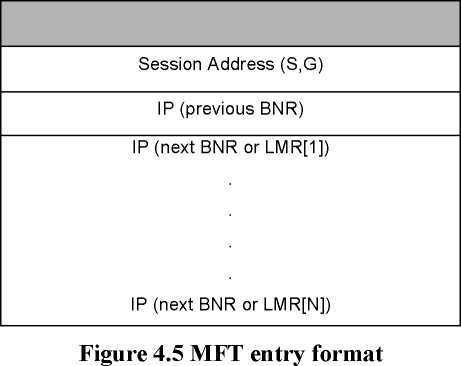The Multicast Forwarding Table (MFT) is created and updated in BNRs (in this sense, the
source is one of the BNRs) to carry an entries to the other BNRs and LMRs connected to it. It
is worth to notice that only branching nodes maintain such table and other multicast tree
members do not have to maintain any tables. This is also an advantage for SReM over related
protocols like REUNITE and HBH where the non-branching nodes should also maintain
MCT tables. The structure of MFT entry, shown at Figure 4.5, is as follows: (The session
address (S,G), IP_previous branching node, IP_next Branching node and/or IP_LMRs). This
table is created and updated in response to branching messages. The issue of creating and
updating the MFT will be discussed next section.

4.4 Joining / leaving and BNR Selection Procedure
4.4.1 Service Discovery
Although the service discovery methods are out the scope of this thesis, it is worth
mentioning a brief discussion of them. Service discovery protocols allow devices to discover
automatically network services thus making the task of network administration and
configuration easy. In fixed and wired networks service discovery protocols simplify the
interaction among users, devices and services [73].
The service discovery protocols for wired networks have been divided into three categories.
Directory based, set of nodes that store information about providers. Clients then query these
65
More intriguing information
1. Modelling the health related benefits of environmental policies - a CGE analysis for the eu countries with gem-e32. The name is absent
3. The migration of unskilled youth: Is there any wage gain?
4. The name is absent
5. Proceedings from the ECFIN Workshop "The budgetary implications of structural reforms" - Brussels, 2 December 2005
6. Inflation and Inflation Uncertainty in the Euro Area
7. The name is absent
8. Foreign Direct Investment and the Single Market
9. The quick and the dead: when reaction beats intention
10. Wirkung einer Feiertagsbereinigung des Länderfinanzausgleichs: eine empirische Analyse des deutschen Finanzausgleichs